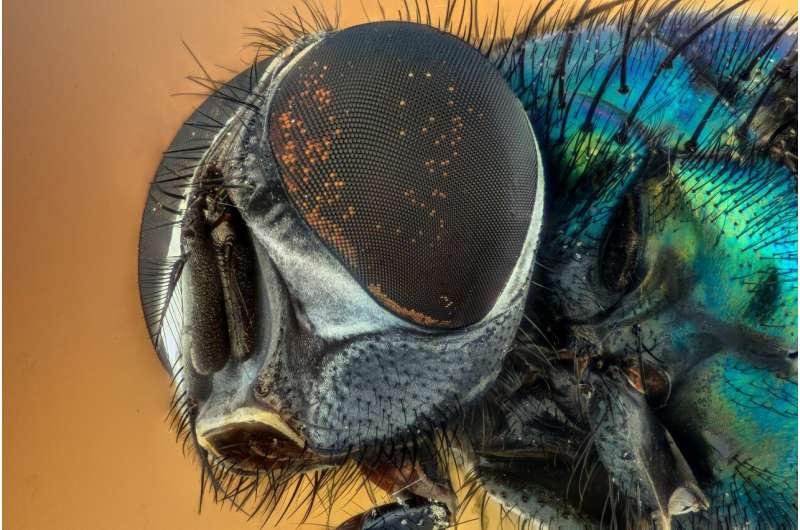Hospital insects harbour drug-resistant bacteria

More than 50 percent of bacteria recovered from flying insects in a group of English hospitals were resistant to one or more antibiotics, posing a potential infection risk to patients, according to a new study.
The Aston University study collected almost 20,000 insect samples—including houseflies, 'filth flies' such as bluebottles and greenbottles and a variety of 'drain flies' - from seven NHS hospital sites in England. Microbiological analysis found that nearly nine in 10 of those tested were carrying potentially harmful bacteria such as E.coli, Salmonella and Staphylococcus aureus, either internally or externally on their bodies.
Flying insects harbouring bacteria were collected from a number of locations throughout the hospitals using ultraviolet (UV) light flytraps, electronic fly killers and sticky traps. They included areas where food for patients, visitors and staff was prepared or stored, as well as wards, neonatal units and maternity units. In some cases, the level of bacteria carried by flying insects was enough to potentially cause infection.
Over three-quarters of the insects collected were 'true flies' – a group which includes midges and common houseflies—with a further 14 percent being 'true bugs' including aphids. Smaller groups of ants, wasps, bees and moths were also collected. The sample collection took place over an 18-month period, with higher numbers being collected in spring and summer.
A total of 86 bacterial strains were isolated from the insect samples. Enterobacteriaceae—a family that includes E.coli and Salmonella—were the most commonly isolated, accounting for 41 percent of isolations from flying insects, followed by Bacillus (which includes the 'food poisoning bug' B.cereus) at 24 percent and staphylococci (which includes S. aureus, a cause of skin infections, abscesses and respiratory infections) comprising 19 percent.
The analysis showed that 53 percent of the strains were resistant to one or more class of antibiotics. Of this figure, 19 percent were resistant to multiple antibiotics, a feature known as multi-drug resistance (MDR). Penicillin was found to be the least effective antibiotic, with many bacteria showing resistance. Resistance to other commonly-administered antibiotics, including vancomycin and levofloxacin, was also observed.
The study, published in the Journal of Medical Entomology, was co-authored by Ph.D. student Federica Boiocchi, and Professor Anthony Hilton, both from Aston University's School of Life and Health Sciences and Dr. Matthew Davies of Killgerm Chemicals Ltd.
Lead author Federica Boiocchi, said:
"The results from this large-scale microbiological analysis show that a variety of flying insects collected from UK hospitals do indeed harbour pathogenic bacteria of different species.
"What's quite interesting, though, is the high proportion of drug-resistant bacteria found in these samples. It's a vivid reminder of how our over-use of antibiotics in healthcare settings is making infections more difficult to treat."
Anthony Hilton, Professor of Applied Microbiology at Aston University, added:
"NHS hospitals are extremely clean environments and the risk of insects carrying bacteria and transferring these to patients is very low.
"What we are saying in this paper is that even in the cleanest of environments, it's important to take steps to prevent bacteria being brought into hospitals by insects. NHS hospitals will already be implementing many of these measures, but there are simple steps that can be taken to improve this further.
"Infection control is taken extremely seriously in the NHS. Insects will only play a very small role in the transfer of bacteria, so this risk should be seen in the context of wider efforts to stop the spread of harmful and drug-resistant bacteria."
Dr. Matthew Davies, of Killgerm Chemicals Ltd, said:
"We hope this study is useful for those in charge of pest management measures, for example by highlighting when insects are likely to be most prevalent and which are of the greatest risk to public health, therefore informing the selection of quality insect monitors and effective UV light traps to be installed, among other integrated pest management measures provided by professionals.
"It could also mean emphasising the importance of replacing perishable components such as glue boards more frequently, and monitoring the insect catch closely, especially during the warmer months."
More information: An Examination of Flying Insects in Seven Hospitals in the United Kingdom and Carriage of Bacteria by True Flies (Diptera: Calliphoridae, Dolichopodidae, Fanniidae, Muscidae, Phoridae, Psychodidae, Sphaeroceridae). Journal of Medical Entomology. DOI: 10.1093/jme/tjz086

















